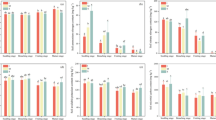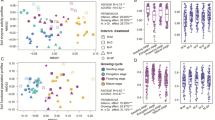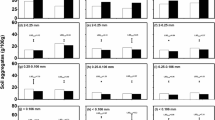Abstract
Intercropping is a powerful practice to alter the allocation of photosynthetic carbon (C) to belowground ecosystems via promotion of diversified plant communities. The feedback of soil C stability to intercropping is controlled by microbial C use efficiency (CUE). Despite its significance, there is currently insufficient evidence to decipher how soil microbial CUE reacts to intercropping. By combining a 10-year-long intercropping experiment with a substrate-independent 18O-H2O labelling approach and high-throughput sequencing, we elucidated the performance of intercropping on soil C pool and microbial metabolic traits as well as their relationships with soil microbial communities. Compared with monoculture, maize intercropping with peanut and soybean significantly increased soil C storage, soil mineral-associated organic C (MAOC), soil dissolved organic (DOC), and soil microbial biomass (MBC) contents at maize four growth stages. Soil microbial CUE increased significantly, especially at maize flowering and mature stages, as a consequence of enhanced microbial growth and biomass turnover rate after maize intercropping with peanut and soybean. Soil C storage and accessibility indicators (e.g., MAOC, DOC, and MBC contents) could significantly predict the changes of soil microbial diversity and core taxa. Meanwhile, the beta-diversity (community composition) of soil bacteria, fungi, saprotroph and protists, as well as rare fungal taxa were positively correlated with soil microbial CUE, and these indicators showed a high prediction of the microbial CUE. Soil C storage and accessibility indicators directly and indirectly influenced soil microbial CUE by regulating microbial diversity and key taxa. Soil microbial diversity and core taxa directly and indirectly influenced microbial CUE by mediating microbial respiration, growth, biomass, and enzyme activity, which mediated by soil C storage and accessibility. These findings provide an evidence for the associations between microbial diversity, CUE, and soil C stability, highlighting the importance of intercropping-driven soil microbiome to enhance soil microbial CUE.







Similar content being viewed by others
Data availability
All data generated or analyzed during this study are included in this article and its supplementary file.
References
Banerjee S, van der Heijden MGA (2023) Soil microbiomes and one health. Nat Rev Microbiol 21:6–20
Bao SD (2000) Soil and Agro-chemistry Analysis, 3rd edn. China Agricultrual, Beijing
Bastida F, Eldridge DJ, García C, Png GK, Bardgett RD, Delgado-Baquerizo M (2021) Soil microbial diversity–biomass relationships are driven by soil carbon content across global biomes. ISME J 15:2081–2091
Biddle JF, Fitz-Gibbon S, Schuster SC, Brenchley JE, House CH (2008) Metagenomic signatures of the Peru Margin subseafloor biosphere show a genetically distinct environment. PNAS 105:10583–10588
Booth MS, Stark JM, Rastetter E (2005) Controls on nitrogen cycling in terrestrial ecosystems: a synthetic analysis of literature data. Ecol Monogr 75:139–157
Börger M, Bublitz T, Dyckmans J, Dyckmans J, Wachendorf C, Joergense RG (2022) Microbial carbon use efficiency of litter with distinct C/N ratios in soil at different temperatures, including microbial necromass as growth component. Biol Fertil Soils 58:761–770
Bradford MA, Wieder WR, Bonan GB, Fierer N, Raymond PA, Crowther TW (2016) Managing uncertainty in soil carbon feedbacks to climate change. Nat Clim Change 6:751–758
Callahan BJ, McMurdie PJ, Rosen MJ, Han AW, Johnson AJA, Holmes SP (2016) DADA2: high-resolution sample inference from Illumina amplicon data. Nat Methods 13:581–583
Cappelli SL, Domeignoz-Horta LA, Loaiza V, Laine AL (2022) Plant biodiversity promotes sustainable agriculture directly and via belowground effects. Trends Plant Sci 27:674–687
Chen J, Luo Y, van Groenigen KJ, Hungate BA, Cao J, Zhou X, Wang R (2018) A keystone microbial enzyme for nitrogen control of soil carbon storage. Sci Adv 4:eaaq1689
Chen J, Ji C, Fang J, He H, Zhu B (2020) Dynamics of microbial residues control the responses of mineral-associated soil organic carbon to N addition in two temperate forests. Sci Total Environ 748:141318
Cheng X, Xing W, Liu J (2023) Litter chemical traits, microbial and soil stoichiometry regulate organic carbon accrual of particulate and mineral-associated organic matter. Biol Fertil Soils 59:777–790
Cong WF, Hoffland E, Li L, Six J, Sun JH, Bao XG, Zhang F, Van Der Werf W (2015) Intercropping enhances soil carbon and nitrogen. Glob Chang Biol 21:1715–1726
Csardi G, Nepusz T (2006) The igraph software package for complex network research. Int j Complex syst 1695:1–9
Deforest JL (2009) The influence of time, storage temperature, and substrate age on potential soil enzyme activity in acidic forest soils using MUB-linked substrates and l-dopa. Soil Biol Biochem 41:1180–1186
Delgado-Baquerizo M, Reich PB, Trivedi C, Eldridge DJ, Abades S, Alfaro FD, Bastida F, Berhe AA, Cutler NA, Gallardo A (2020) Multiple elements of soil biodiversity drive ecosystem functions across biomes. Nat Ecol Evol 4:210–220
Duchene O, Vian JF, Celette F (2017) Intercropping with legume for agroecological cropping systems: complementarity and facilitation processes and the importance of soil microorganisms. Agric Ecosyst Environ 240:148–161
Ellert BH, Bettany JR (1995) Calculation of organic matter and nutrients stored in soils under contrasting management regimes. Can J Soil Sci 75:529–538
Fan Y, Chen J, Shirkey G (2016) Applications of structural equation modeling (SEM) in ecological studies: an updated review. Ecol Process 5:19
Fan K, Delgado-Baquerizo M, Guo X, Wang D, Zhu Y, Chu H (2020) Biodiversity of key-stone phylotypes determines crop production in a 4-decade fertilization experiment. ISME J 15:550–561
Feng J, Zeng XM, Zhang Q, Zhou XQ, Liu YR, Huang Q (2021) Soil microbial trait-based strategies drive metabolic efficiency along an altitude gradient. ISME Commu 1:71
Feng X, Qi S, Zhang D, Chen P, Hu J, Wang G, Liu Y, Wei B, Li Q, Yang Y, Chen L (2022) Nitrogen input enhances microbial carbon use efficiency by altering plant-microbe-mineral interactions. Glob Chang Biol 00:1–16
Fornara DA, Tilman D (2012) Soil carbon sequestration in prairie grasslands increased by chronic nitrogen addition. J Ecol 93:2030–2036
Fornara DA, Banin L, Crawley MJ (2013) Multi-nutrient vs. nitrogen-only effects on carbon sequestration in grassland soils. Glob Chang Biol 19:3848–3857
Genuer R, Poggi JM (2020) Introduction to Random forests with R. Random forests with R. Use R! Springer, Cham
Ghannoum MA, Jurevic RJ, Mukherjee PK, Cui F, Sikaroodi M, Naqvi A (2010) Characterization of the oral fungal microbiome (mycobiome) in healthy individuals. PLOS Pathog 6:e1000713
Guo J, Ling N, Li Y, Li K, Ning H, Shen Q, Guo S, Vandenkoornhuyse P (2021) Seed-borne, endospheric and rhizospheric core microbiota as predictors of plant functional traits across rice cultivars are dominated by deterministic processes. New Phytol 230:2047–2060
Hagerty SB, van Groenigen KJ, Allison SD, Hungate BA, Schwartz E, Koch GW, Dijkstra P (2014) Accelerated microbial turnover but constant growth efficiency with warming in soil. Nat Clim Change 4:903–906
Hall M, Beiko RG (2018) 16S rRNA gene analysis with QIIME2. Methods Mol Biol 1849:113–129
Hopkins FM, Torn MS, Trumbore SE (2015) Warming accelerates decomposition of decades-old carbon in forest soils. PNAS 109:1753–1761
Huang X, Wang J, Dumack K, Liu W, Zhang Q, He Y, Di H, Bonkowski M, Xu J, Li Y (2021) Protists modulate fungal community assembly in paddy soils across climatic zones at the continental scale. Soil Biol Biochem 160:108358
Jansson JK, Hofmockel KS (2020) Soil microbiomes and climate change. Nat Rev Microbiol 18:35–46
Jensen ES, Carlsson G, Hauggaard-Nielsen H (2020) Intercropping of grain legumes and cereals improves the use of soil N resources and reduces the requirement for synthetic fertilizer N: a global-scale analysis. Agron Sustain Dev 40:5
Jiao S, Lu Y (2020) Abundant fungi adapt to broader environmental gradients than rare fungi in agricultural fields. Glob Chang Biol 26:4506–4520
Jiao S, Chen W, Wei G (2017) Biogeography and ecological diversity patterns of rare and abundant bacteria in oil-contaminated soils. Mol Ecol 26:5305–5317
Kallenbach CM, Grandy AS, Frey SD, Diefendorf AF (2015) Microbial physiology and necromass regulate agricultural soil carbon accumulation. Soil Biol Biochem 91:279–290
Kallenbach CM, Frey SD, Grandy AS (2016) Direct evidence for microbial-derived soil organic matter formation and its ecophysiological controls. Nat Commun 7:13630
Khan KS, Mack R, Castillo X, Kaiser M, Joergensen RG (2016) Microbial biomass, fungal and bacterial residues, and their relationships to the soil organic matter C/N/P/S ratios. Geoderma 271:115–123
Kokou F, Sasson G, Friedman J, Eyal S, Ovadia O, Harpaz S, Cnaani A, Mizrahi I (2019) Core gut microbial communities are maintained by beneficial interactions and strain variability in fish. Nat Microbiol 4:2456–2465
Lal R (2015) Soil carbon sequestration impacts on global climate change and food security. Science 304:1623–1627
Lange M, Eisenhauer N, Sierra C, Gleixner G (2015) Plant diversity increases soil microbial activity and soil carbon storage. Nat Commun 6:6707
Langfelder P, Horvath S (2008) WGCNA: an R package for weighted correlation network analysis. BMC Bioinform 9:559
Langfelder P, Horvath S (2012) Fast R functions for robust correlations and hierarchical clustering. J Stat Softw 46:11
Lavallee JM, Soong JL, Cotrufo MF (2020) Conceptualizing soil organic matter into particulate and mineral-associated forms to address global change in the 21st century. Glob Chang Biol 26:261–273
Lazcano C, Boyd E, Holmes G, Pasulka A, Ivors K (2021) The rhizosphere microbiome plays a role in the resistance to soil-borne pathogens and nutrient uptake of strawberry cultivars under field conditions. Sci Rep 11:3188
Li C, Hoffland E, Kuyper TW, Yu Y, Zhang C, Li H, van der Zhang F W (2020) Syndromes of production in intercropping impact yield gains. Nat Plants 6:653–660
Li L, Liu Y, Li X (2021) Intercropping to maximize root-root interactions in agricultural plants. Root Syst Sustainable Agricultural Intensif 12:309–328
Li X, Jin Z, Xiong L, Tong L, Zhu H, Zhang X, Qin G (2022) Effects of land reclamation on soil bacterial community and potential functions in Bauxite mining area. Int J Environ 19:16921
Liang C, Schimel JP, Jastrow JD (2017) The importance of anabolism in microbial control over soil carbon storage. Nat Microbiol 2:17105
Ling N, Wang T, Kuzyakov Y (2022) Rhizosphere bacteriome structure and functions. Nat Commun 13:836
Liu X, Shi X, Zhang S (2021) Soil abiotic properties and plant functional diversity co-regulate the impacts of nitrogen addition on ecosystem multifunctionality in an alpine meadow. Sci Total Environ 780:146496
Lu M, Zhou X, Luo Y, Yang Y, Fang C, Cheng J, Li B (2011) Minor stimulation of soil carbon storage by nitrogen addition: a meta-analysis. Agric Ecosyst Environ 140:234–244
Malik AA, Martiny JBH, Brodie EL, Martiny AC, Treseder KK, Allison SD (2020) Defining trait-based microbial strategies with consequences for soil carbon cycling under climate change. ISME J 14:19
Manzoni S, Taylor P, Richter A, Porporato A, Agren GI (2012) Environmental and stoichiometric controls on microbial carbon-use efficiency in soils. 196:79–91New Phytol
Mohammadi-Sichani MM, Assadi MM, Farazmand A, Kianirad M, Ahadi AM, Hadian Ghahderijani H (2017) Bioremediation of soil contaminated crude oil by Agaricomycetes. J Environ Health Sci Eng 15:8
Moran-Rodas VE, Joergensen RG, Wachendorf C (2023) Does liming improve microbial carbon use efficiency after maize litter addition in a tropical acidic soil? Biol Fertil Soils 59:619–627
Ndabankulu K, Egbewale SO, Tsvuura Z, Magadlela A (2022) Soil microbes and associated extracellular enzymes largely impact nutrient bioavailability in acidic and nutrient poor grassland ecosystem soils. Sci Rep 12:12601
Nguyen NH, Song Z, Bates ST, Branco S, Tedersoo L, Menke J, Kennedy PG (2016) FUNGuild: an open annotation tool for parsing fungal community datasets by ecological guild. Fungal Ecol 20:241–248
Ogawa Y, Hayashi S, Degawa Y, Yaguchi Y (2001) Ramicandelaber, a new genus of the Kickxellales. Zygomycetes Mycoscience 42:193–199
Robinson DA, Thomas A, Reinsch S, Lebron CJ, Feeney LC, Maskell CM, Wood FM, Seaton BA, Emmett BJ (2022) Analytical modelling of soil porosity and bulk density across the soil organic matter and land-use continuum. Sci Rep 12:7085
Roth V, Lange M, Simon C, Hertkorn N, Bucher S, Goodall T, Gleixner G (2019) Persistence of dissolved organic matter explained by molecular changes during its passage through soil. Nat Geosci 12:755–761
Roy J, Mazel F, Dumack K, Bonkowski M, Rillig MC (2022) Hierarchical phylogenetic community assembly of soil protists in a temperate agricultural field. Environ Microbiol 24:5498–5508
Ryan MR (2021) Crops better when grown together. Nat Sustain 4:926–927
Simon SM, Glaum P, Valdovinos FS (2023) Interpreting random forest analysis of ecological models to move from prediction to explanation. Sci Rep 13:3881
Spohn M, Klaus K, Wanek W, Richter A (2016) Microbial carbon use efficiency and biomass turnover times depending on soil depth - implications for carbon cycling. Soil Biol Biochem 96:74–81
Stoeck T, Bass D, Nebel M, Christen R, Jones MD, Breiner HW, Richards TA (2010) Multiple marker parallel tag environmental DNA sequencing reveals a highly complex eukaryotic community in marine anoxic water. Mol Ecol 19:21–31
Tarka P (2018) An overview of structural equation modeling: its beginnings, historical development, usefulness and controversies in the social sciences. Qual Quant 52:313–354
Tedersoo L, Sánchez-Ramírez S, Koljalg U, Bahram M, Döring M, Schigel D, May T, Ryberg M, Abarenkov K (2018) High-level classification of the Fungi and a tool for evolutionary ecological analyses. Fungal Divers 90:135–159
Treseder KK (2008) Nitrogen additions and microbial biomass: a meta-analysis of ecosystem studies. Ecol Lett 11:1111–1120
Vance ED, Brookes PC, Jenkinson DS (1987) An extraction method for measuring soil microbial biomass C. Soil Biol Biochem 19:703–707
Wagg C, Schlaeppi K, Banerjee S, Kuramae EE, van der Heijden MG (2019) Fungal-bacterial diversity and microbiome complexity predict ecosystem functioning. Nat Commun 10:1–10
Walker TWN, Kaiser C, Strasser F, Herbold CW, Leblans NIW, Woebken D, Janssens IA, Sigurdsson BD, Richter A (2018) Microbial temperature sensitivity and biomass change explain soil carbon loss with warming. Nat Clim Change 8:885–889
Wang C, Qu L, Yang L, Liu D, Morrissey E, Miao R, Liu Z, Wang Q, Fang Y, Bai E (2021) Large-scale importance of microbial carbon use efficiency and necromass to soil organic carbon. Glob Chang Biol 27:2039–2048
Wang Y, Zhang Y, Zhang H, Yang Z, Zhu Q, Yan B, Fei J, Rong X, Peng J, Luo G (2022a) Intercropping-driven nitrogen trade-off enhances maize productivity in a long-term experiment. Field Crops Res 287:108671
Wang M, Dungait JA, Wei X, Ge T, Hou R, Ouyang Z, Zhang F, Tian J (2022b) Long-term warming increased microbial carbon use efficiency and turnover rate under conservation tillage system. Soil Biol Biochem 172:108770
Wani AK, Akhtar N, Sher F, Aparecido A, Heloisa NJ, Américo-Pinheiro P (2022) Microbial adaptation to different environmental conditions: molecular perspective of evolved genetic and cellular systems. Arch Microbiol 204:144
Wieder WR, Bonan GB, Allison SD (2013) Global soil carbon projections are improved by modelling microbial processes. Nat Clim Change 3:909–912
Williams A, de Vries FT (2019) Plant root exudation under drought: implications for ecosystem functioning. New Phytol 225:1899–1905
Xu Y, Gao X, Pei J, Sun L, Wang J (2022) Crop root vs. shoot incorporation drives microbial residue carbon accumulation in soil aggregate fractions. Biol Fertil Soils 58:843–854
Yang Z, Zhang Y, Wang Y, Zhang H, Zhu Q, Yan B, Fei J, Rong X, Peng J, Luo G (2022) Intercropping regulation of soil phosphorus composition and microbially-driven dynamics facilitates maize phosphorus uptake and productivity improvement. Field Crops Res 287:108666
Young JM, Park DC, Shearman HM, Fargier E (2008) A multilocus sequence analysis of the genus Xanthomonas. Syst Appl Microbiol 31:366–377
Zhang B, Horvath S (2005) A general framework for weighted gene co-expression network analysis. Stat Appl Genet Mol Biol 4:17
Zhang X, Xin X, Zhu A, Zhang J, Yang W (2017) Effects of tillage and residue managements on organic C accumulation and soil aggregation in a sandy loam soil of the North China Plain. CATENA 156:176–183
Zhao Q, Jian S, Nunan N, Maestre FT, Tedersoo L, He J, Wei H, Tan X, Shen W (2017) Altered precipitation seasonality impacts the dominant fungal but rare bacterial taxa in subtropical forest soils. 53:231–245Biol Fertil Soils
Zhou WJ, Sha LQ, Schaefer DA, Zhang YP, Song QH, Tan ZH, Deng Y, Deng XB, Guan HL (2015) Direct effects of litter decomposition on soil dissolved organic carbon and nitrogen in a tropical rainforest. Soil Biol Biochem 81:255–258
Zhou Z, Zhang Y, Zhang F (2022) Abundant and rare bacteria possess different diversity and function in crop monoculture and rotation systems across regional farmland. Soil Biol Biochem 171:108742
Acknowledgements
Our work was supported by the National Natural Science Foundation of China (42107262) and the Key Field Research and Development Program of Hunan Province (2023NK2028).
Author information
Authors and Affiliations
Contributions
GL and XW conceived, designed and financially supported the study; ZY and QZ analyzed the data and wrote the paper, and conducted the analytical work with PJ, YW and JF; XR and JP revised the manuscript. All authors read and approved the final manuscript.
Corresponding authors
Ethics declarations
Competing interests
The authors declare that they have no known competing financial interests or personal relationships that could have appeared to influence the work.
Additional information
Publisher’s Note
Springer Nature remains neutral with regard to jurisdictional claims in published maps and institutional affiliations.
Electronic supplementary material
Below is the link to the electronic supplementary material.
Rights and permissions
Springer Nature or its licensor (e.g. a society or other partner) holds exclusive rights to this article under a publishing agreement with the author(s) or other rightsholder(s); author self-archiving of the accepted manuscript version of this article is solely governed by the terms of such publishing agreement and applicable law.
About this article
Cite this article
Yang, Z., Zhu, Q., Zhang, Y. et al. Soil carbon storage and accessibility drive microbial carbon use efficiency by regulating microbial diversity and key taxa in intercropping ecosystems. Biol Fertil Soils 60, 437–453 (2024). https://doi.org/10.1007/s00374-024-01804-1
Received:
Revised:
Accepted:
Published:
Issue Date:
DOI: https://doi.org/10.1007/s00374-024-01804-1




